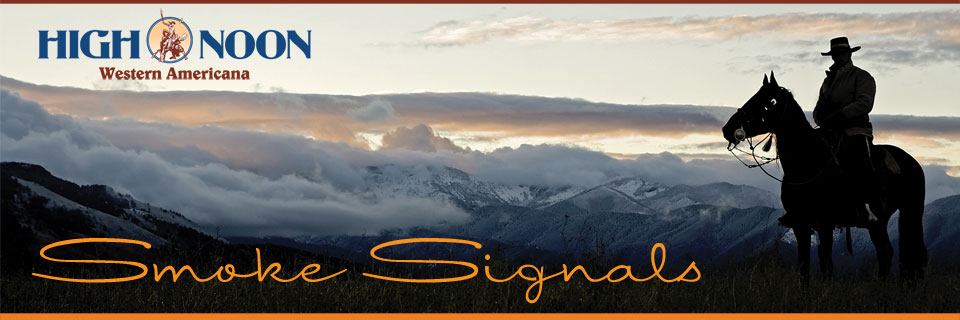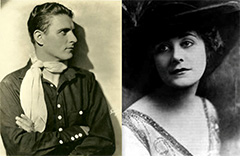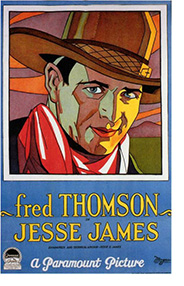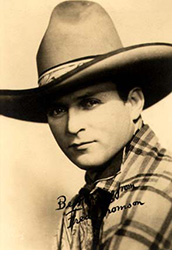
![]()
Roaming Range Reporter
Continued from September 2012, Smoke Signals
 Reel Cowboys of Western Cinema
Reel Cowboys of Western Cinema
A Century of Silver Screen Heroes on Horseback
By Gary Eugene Brown
Over hundred matinee idols have ridden across the silver screen. Many had been hired men on horseback in a prior life. However, there were a few thespians, city born and bred, who rode as though they were one with the horse. One of the best is featured in this months' continuing series.
FRED THOMSON
Contrary to a studio's desire to glamorize their western star by claiming he was born astride a horse in El Paso, Frederick Clifton Thomson's birthplace was Pasadena, California. Born to Reverend Williell and Clara Thomson on February 26, 1890, Fred was the third of four boys. After high school, he attended nearby Occidental College, a Presbyterian university. Fred went on to excel in football, baseball, was Captain of the Track and Field team and became Student Body President.
Upon graduation, Fred was invited to Chicago (1910) by the AAU to compete with the best athletes for the title of "World's Greatest All-Around Athlete". Fred participated in 10 (Decathlon) events against 15 other world class athletes. Winning the meet, he was hailed by the newspapers: "Thomson Champion of United States"; "Westerner Wins World's Honors"; Thomson All-Around Champion Athlete"; and the LA Times headline: "He Did It, All Right". Fred would go on to win the AAU All Around Athlete title on two more occasions. Fred however, declined to participate in the 1912 Olympics, as he was enrolled in Princeton Theological Seminary, following in his father's footsteps to become an Ordained Minister. As such, he didn't have time to adequately prepare for the summer games, plus he'd have to halt his preaching to the less fortunate at Peck Memorial Chapel in Washington DC. However, Fred continued to participate in Track and Field Events, time permitting, and eventually would break the Decathlon record. Fred even passed the total points, legendary Jim Thorpe accumulated in the Stockholm Olympic Games.
After graduating from Princeton, Fred returned to Los Angeles (1913) and filled the pulpit at Grace Chapel. Fred loved being a minister of the Word and wrote articles on how to live a clean, moral lifestyle. Also, he renewed his interest in a young, attractive coed Gail Jepson, who he had met at Occidental. After a short engagement, the two married. Gail played piano during the services and taught Sunday school. The young couple moved to Goldfield, Nevada, where a new gold discovery revived the community. Fred developed a reputation of being an outstanding preacher and a person interested in helping youth. This led to his being named the Nevada Commissioner for a relatively new organization, the Boy Scouts of America. After much success and happiness, heartbreak set in, testing his faith. First, his father died and then Gail took ill and passed away from tuberculosis. Fred couldn't grieve long as the country was facing a new challenge....the possibility of war in Europe.
As a boy, Fred wanted to be a soldier. So the call to arms was too hard to resist. Fred accepted a Chaplain's position with the US Army, Battery F, 143rd Field Artillery Regiment. While waiting an overseas assignment at Camp Kearney, Fred joined the outfit's football team. The Honorary Colonel of the 143rd was Hollywood's most popular actress Mary Pickford. Taking her role seriously, Mary visited Camp Kearney and sought out the 6'2, 200 lb., blue eyed Greek Adonis with wavy brown hair to stand next to in a company photo. On her second visit, Ms. Pickford brought her closest friend, the popular scriptwriter - Frances Marion*. Frances was to go to Europe as a War Correspondent and thought the visit would be valuable experience. Mary introduced Frances to Fred and it didn't take long for the two to get engaged. Frances in her autobiography described it as "love at first sight." Fred's fiancé followed him to France. However, the Armistice was called before Fred saw action.
 Fred and Marion were married in a private ceremony on November 2, 1919 in New York City. Mary Pickford served as Maid of Honor. A few months later Mary would marry Doug Fairbanks and the two famous movie stars honeymooned in Europe. Fred and Frances joined the two super stars later on. The men while watching a Netherlands college track team practice, decided to join in. The Dutch, not knowing Fred was a world class athlete, were taken back when he did everything they did, only better. Fairbanks took great pleasure in sharing that "America lost the vote of Holland in the League of Nations when Fred insulted them by keeping his hat and coat on and jumping six inches higher (in the high jump) than they could in track suits!"
Fred and Marion were married in a private ceremony on November 2, 1919 in New York City. Mary Pickford served as Maid of Honor. A few months later Mary would marry Doug Fairbanks and the two famous movie stars honeymooned in Europe. Fred and Frances joined the two super stars later on. The men while watching a Netherlands college track team practice, decided to join in. The Dutch, not knowing Fred was a world class athlete, were taken back when he did everything they did, only better. Fairbanks took great pleasure in sharing that "America lost the vote of Holland in the League of Nations when Fred insulted them by keeping his hat and coat on and jumping six inches higher (in the high jump) than they could in track suits!"
Frances had been married twice before which precluded Fred from going back to preaching. However, Fred's love for Frances exceeded his love for the ministry. Fred decided to acquire a horse and train it for the movies. He found a dapple gray, 17 hands, Irish Jumper. Fred spent hours training the horse he called Silver King. The horse was to be the star as he had little interest in becoming an actor. However, Fred was aware of the immense popularity of William S Hart and Tom Mix and their being positive role models for American youth. Eventually, his photogenic looks and athletic build, led to a few parts in films. One was a major costarring role with Mary Pickford in The Love Light, written and directed by Frances. Then Fred was given the lead in a 15 chapter, action packed serial The Eagle's Talons with billing as "The World's Champion Athlete." Later, Frances introduced Fred to FBO's Joseph P. Kennedy. The studio chief convinced Fred he should be a star in western films and Silver King, second billing. Al Rogell directed Fred's first seven western photoplays. He described his leading man: "Fred could do everything physically required of a true Western star and was one of the few well-educated men in Westerns." He "could out ride, jump a horse, and handle one just as well as anyone with the exception of Hoot Gibson and Art Acord."
The first western at Monogram Studios (distributed by FBO), was The Mask of Lopez (January 1924). Reviews were positive and comments included "It seems as though the producer (Harry Joe Brown) has something worthwhile in Fred Thomson....." Two of the cowboy's most ardent and admiring fans were two boys, Joe and Jack Kennedy, the eldest sons of the Executive Producer. Fred met the future President of the USA when probably all that JFK wanted at that time was to grow up and be like his hero Fred Thomson.
One of the western photoplays Fred starred in was Thundering Hoofs (October 1924). Sadly, it is the only known surviving film (in its entirety) of Fred's westerns. The action scenes were akin to Tom Mix's daring stunts on horseback and the acrobatic feats of Douglas Fairbanks. The film included a scene where Fred gallops up on Silver King to catch the runaway stagecoach, with the female heroine aboard. Fred leapt onto the left wheel horse; however the horse stumbled throwing Fred beneath the wheels of the coach. Fred sustained a major break of his thigh bone, which required hospitalization. While Fred was recuperating, Al Rogell summoned Yakima Canutt to complete the scene. They used the actual vault of Fred on to the horse and his fall and then Yak was inserted into the scene. Rogell wanted Fred to defer dangerous stunts to the stuntmen and actor eventually agreed. However first, he would perform the stunt for the double to show him the correct movements to minimize injury.
 After completion of 20 westerns for Joseph Kennedy, Fred was a major drawing card in theaters across the country. 10,000+ theater owners claimed Fred Thomson was their biggest draw at the box office. Tom Mix was the number one male star in Hollywood among independent theater owners (1927). However, Fred was a close second in the poll. Following the two megastar cowboys were: Lon Chaney, Richard Dix, Hoot Gibson and Harold Lloyd. Paramount Studios, aware of his immense popularity, was able to secure a contract with Fred with Kennedy providing their financing. Jesse James (Oct 27) was the first film made for Paramount. It was a big budget, epic film. The Technical Advisor was Jesse E. James, son of the legendary outlaw. The screenwriter was Frank M. Clifton (Frances Marion). The film opened in the largest theaters in the country. Initially, the reviews were glowing; however there was a backlash by some who claimed it was an attempt to make Jesse James appear as a folk hero. Fred defended some of the actions of the James boys against the carpet baggers, which did not fare well with the Yankee film critics. None the less, it was truly a major western film. Fred made three more movies for Paramount: The Pioneer Scout, The Sunset Legion and Kit Carson (June 28). At the completion of the films for Paramount, rumors persisted Fred would sign with MGM or Fox to make "talking" westerns.
After completion of 20 westerns for Joseph Kennedy, Fred was a major drawing card in theaters across the country. 10,000+ theater owners claimed Fred Thomson was their biggest draw at the box office. Tom Mix was the number one male star in Hollywood among independent theater owners (1927). However, Fred was a close second in the poll. Following the two megastar cowboys were: Lon Chaney, Richard Dix, Hoot Gibson and Harold Lloyd. Paramount Studios, aware of his immense popularity, was able to secure a contract with Fred with Kennedy providing their financing. Jesse James (Oct 27) was the first film made for Paramount. It was a big budget, epic film. The Technical Advisor was Jesse E. James, son of the legendary outlaw. The screenwriter was Frank M. Clifton (Frances Marion). The film opened in the largest theaters in the country. Initially, the reviews were glowing; however there was a backlash by some who claimed it was an attempt to make Jesse James appear as a folk hero. Fred defended some of the actions of the James boys against the carpet baggers, which did not fare well with the Yankee film critics. None the less, it was truly a major western film. Fred made three more movies for Paramount: The Pioneer Scout, The Sunset Legion and Kit Carson (June 28). At the completion of the films for Paramount, rumors persisted Fred would sign with MGM or Fox to make "talking" westerns.
In 1924, the popular couple decided to build their dream home. They purchased a large parcel overlooking Beverly Hills and built a palatial palace. "Enchanted Hill" included a ballroom, theater, music room, library, wine cellar, swimming pool, tennis court, eight car garage, separate guest house, bird aviary, and a two story stable with a large arena for their 10 white horses. On December 8, 1926, Frances gave birth to Frederick Clifton Thomson, Jr. On October 28, 1927 they adopted Richard Gordon Thomson as a playmate for Fred Jr. The new addition added a special blessing to the magical life on Enchanted Hill.
The Thomson's were planning activities for Christmas 1928, when Frances noticed Fred limping. He then took seriously ill and was rushed to the Queen of Angels Hospital. The initial diagnosis was Fred suffered from Kidney or Gall stones. Newspapers throughout the world began tracking the popular screen cowboy's plight. Most weren't too worried as Fred was in tremendous physical condition. However, the medical staff finally realized they had misdiagnosed the illness. He was suffering from blood poisoning (tetanus) as result of stepping on a rusty nail. Fred died on Christmas day. The Los Angeles Times (Dec. 26, 1928) noted: "He was in his wife's arms and had asked about his relatives and friends in the screen world. 'Frances, I love you so'. With those words he died."
The larger than life cowboy hero's memorial service was attended by the Who's Who in old Hollywood. Pall Bearers included William Randolph Hearst, Harold Lloyd, and Charles Farrell with Douglas Fairbanks and Buster Keaton as honorary pall bearers. In attendance, were a visibly shaken Tom Mix, Louis B Meyer, Mary Pickford, Samuel Goldwyn, William S Hart, Cecil B. De Mille and Walter Pigeon, among many celebrity mourners. Fred was interned in Forest Lawn Memorial Park in Glendale, California.
Photo Play Magazine featured a tribute a few months later entitled "Beyond the Great Divide." The article read "The passing of Fred Thomson means more than an absence of a star from the screen. Many stars remain, but few stand for the ideals Fred Thomson inspired in the minds and hearts of those who loved him. His pictures recreated the glamour and beauty of the West of a bygone day, and his gallant figure and noble bearing crystallized the aspirations of youth." Fred Thomson was indeed......"more than a cowboy!"
_________________
* Frances Marion was the highest paid screenwriter in Hollywood. She went on to win two Oscars: The Big House (1930), Best Adaptation Screenplay; The Champ (1932), Best Story.
For further information refer to:
More Than a Cowboy - The Life and Films of Fred Thomson and Silver King, Edgar M. Wyatt, Wyatt Classics
The Strong, Silent Type (Over 100 Screen Cowboys 1903-1930), Buck Rainey, McFarland & Company
Western Clippings, "The Best & Worst of Silent Westerns", Boyd Magers, (Film Review of Thundering Hoofs)
________________________________________________________________________
GARY E BROWN
is the retired Police Chief of Monterey, CA; Ashland, OR and San Clemente. However, his avocation is collecting western art and memorabilia including many Tom Mix items. Tom Mix was his father's hero, so he is Gary's as well. Gary wrote an article on Tom Mix for The National Film & Collectors Magazine - Hollywood Studio Magazine, as well as a recent article on Tom Mix's final day for American Cowboy magazine. He has also written articles on the Western Photoplays of the Golden Era and lectured on the Western Heroes of the Silver Screen. He can be reached at montereycowboy@hotmail.com or found, most mornings, at his son Jordan's Mavericks Coffee House in Visalia, CA....the site of "possibly the best coffee in the world" with walls of vintage cowboy movie posters and a collection of 66 original, autographed photos of yesterday's cowboy heroes.
If problems with website occur, please contact the webmaster. Site designed by Ireland Graphic Design.
